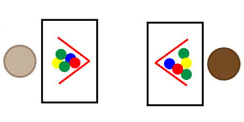Skip over navigation

You also need two matching sets of counters (or something similar - bottle tops, coloured circles of paper etc) - up to 12 in each set.
Give one set to the adult and keep the other set for yourself.
Make a secret place where the adult can hide the counters. You could make a screen with a book, or do it on a tray and cover it up with a piece of cloth.
The adult secretly makes a pattern or design with the counters, describing what they are doing as they make it.
Your job is to make the same design by asking questions, which the adult answers as helpfully as possible.
When you think you have a completed design, ask the adult to check.
If you're right you could swap roles.
If you're wrong keep going!
How many questions did you need to ask?



Or search by topic
Number and algebra
Geometry and measure
Probability and statistics
Working mathematically
Advanced mathematics
For younger learners
En-counters for Two
Age 5 to 7
Challenge Level 





- Problem
Here's a game to play with an adult!

How do you play?
You'll need an adult to play with.You also need two matching sets of counters (or something similar - bottle tops, coloured circles of paper etc) - up to 12 in each set.
Give one set to the adult and keep the other set for yourself.
Make a secret place where the adult can hide the counters. You could make a screen with a book, or do it on a tray and cover it up with a piece of cloth.
The adult secretly makes a pattern or design with the counters, describing what they are doing as they make it.
Your job is to make the same design by asking questions, which the adult answers as helpfully as possible.
When you think you have a completed design, ask the adult to check.
If you're right you could swap roles.
If you're wrong keep going!
How many questions did you need to ask?
Notes for adults
This game is all about using the languge of colour, position and order. Whilst the child is asking you questions you will be limited by the language they already know. Once you swap so that the child is making the original design, you can introduce more sophisticated language into your questioning.
Easier version: use a small number of counters and keep the design very simple, for example in a line. Describe the overall shape of your design at the beginning.
Harder version: use more counters and make a more complicated shape, for example an array.
When you've completed the game, talk together about the questions that helped and those that didn't.
There's a group version of this game here.
This game is all about using the languge of colour, position and order. Whilst the child is asking you questions you will be limited by the language they already know. Once you swap so that the child is making the original design, you can introduce more sophisticated language into your questioning.
Easier version: use a small number of counters and keep the design very simple, for example in a line. Describe the overall shape of your design at the beginning.
Harder version: use more counters and make a more complicated shape, for example an array.
When you've completed the game, talk together about the questions that helped and those that didn't.
There's a group version of this game here.
You may also like
Logic Block Collections
What do you think is the same about these two Logic Blocks? What others do you think go with them in the set?
It's a Fence!
In this challenge, you will work in a group to investigate circular fences enclosing trees that are planted in square or triangular arrangements.
I Like ...
Mr Gilderdale is playing a game with his class. What rule might he have chosen? How would you test your idea?

